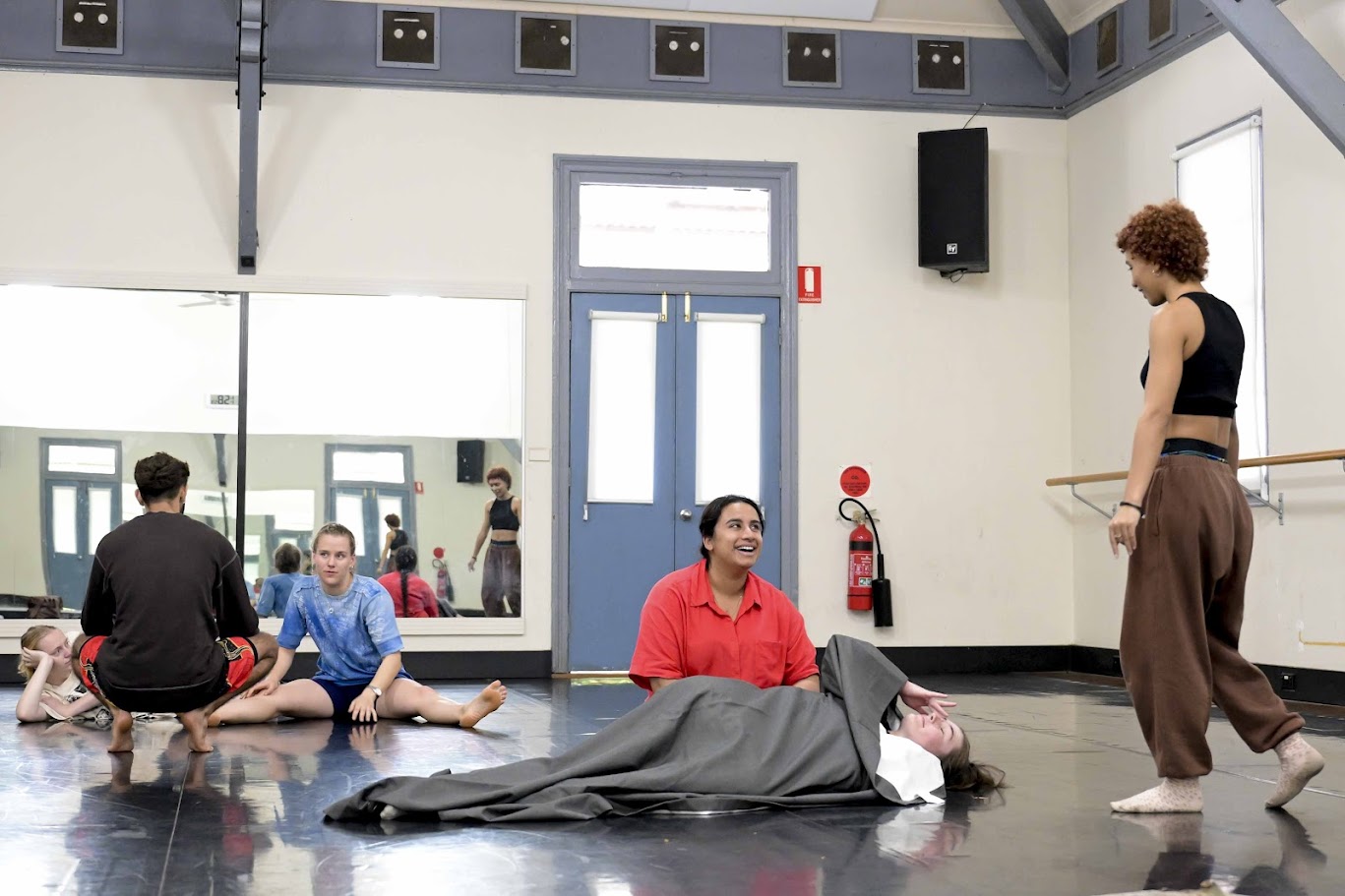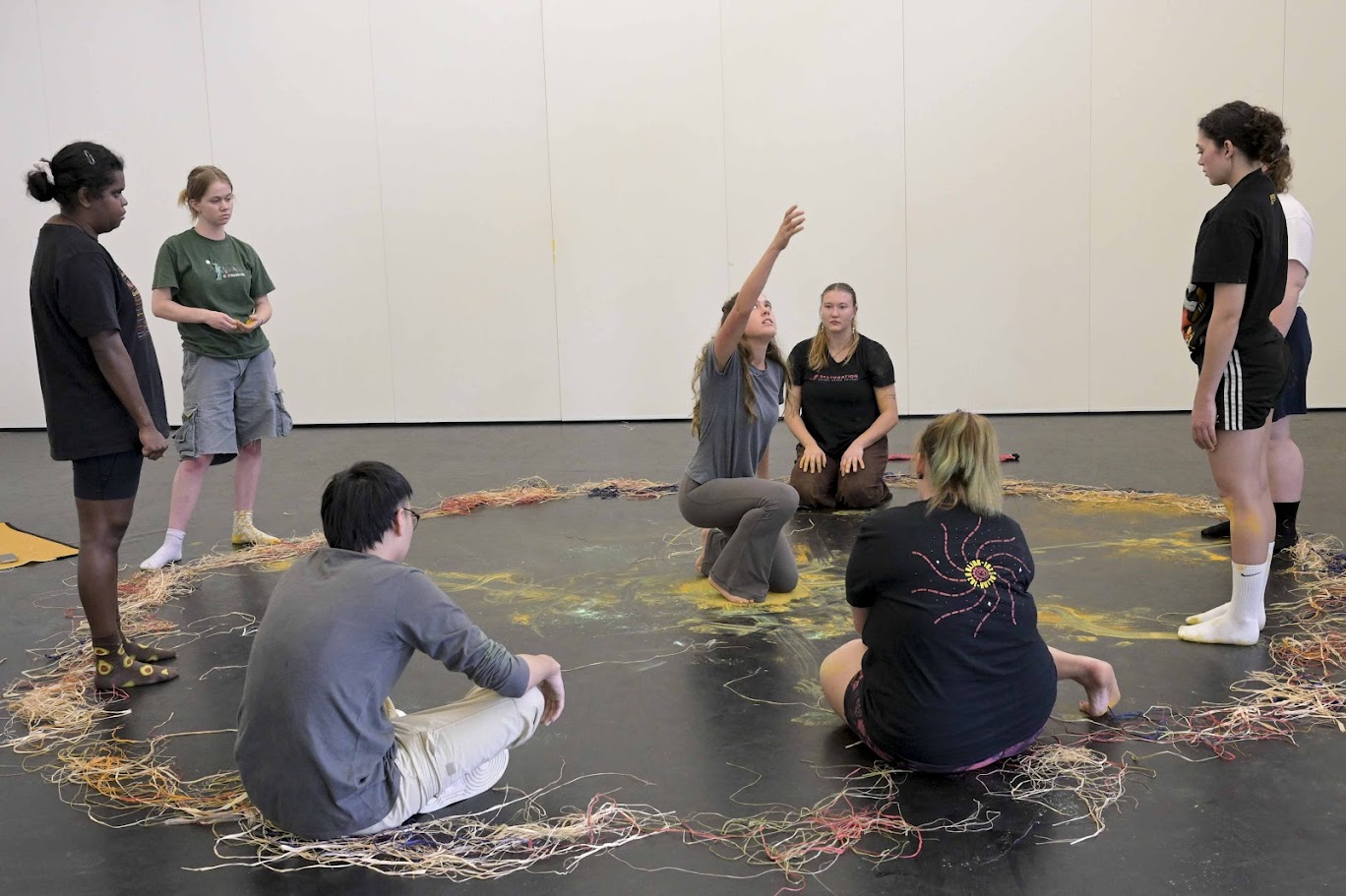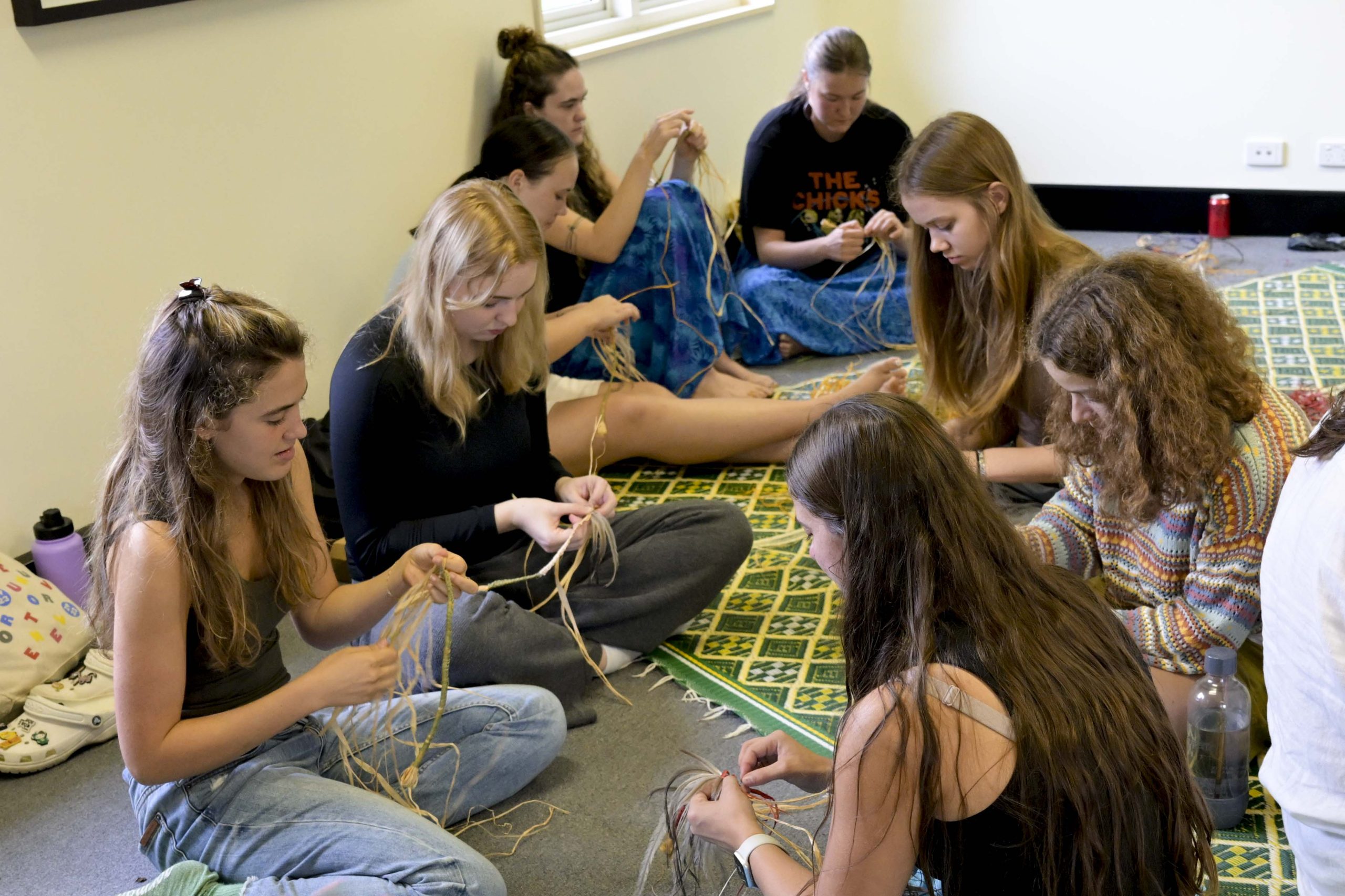NIDA Director and Design students joined NAISDA Developing and Practising Artists to take part in the annual week-long NAISDA NIDA Collaboration earlier this year in March.
Throughout the week, NAISDA and NIDA students participated in workshops, experiences on Country and other programs and practices to explore creative and cultural partnership.
The program culminated at the end of the week with a showing of these works to the rest of the students and staff from both organisations.
We caught up with NIDA students Mehhma Malhi and Bronte Hunt to find out more about the collaboration, what they learned throughout the week and how the collaboration has redefined their artistic practices.
Tell us a little bit about yourselves.
Mehhma: Hi, my name’s Mehhma Malhi, and I’m in the Masters of Directing course at NIDA.
Bronte: I’m Bronte Hunt. I’m in my second year of studying Design for Performance at NIDA in Set and Costume Design.
What has this week involved?
Mehhma: This week has involved many different things. We started off with a Smoking Ceremony and learnt about this region’s cultural significance with Stuart McMinn. We’ve also engaged in activities like weaving, warmups and have learnt more about different kinds of dance practice.
The main chunk of the week was collaborating within our groups to create a movement work for a showing at the end of the week, which has been a really interesting way to devise a piece.
Bronte: On Sunday, we started with a walk from Umina Beach with Stuart McMinn where we gathered and built a big rainbow serpent or eel on the beach. He then told us about the story of the area, and we had a Welcome to Country where we splashed ocean water over ourselves. We went up to Staples Lookout and Stu explained the knowledge held within some nearby rock carvings, which was a really lovely start to the week.
During the week we had so many different workshops including Dr Nerida Blair’s amazing Lilyology workshop about the space in between Indigenous and Western practice and how we can be in that space together, creating.
In a cultural Torres Strait Islander workshop we learnt a song and a cultural dance with the NAISDA students. It was so amazing singing and dancing together. Everyone at NAISDA was so welcoming and we loved joining in.
There was also a circus workshop hosted by the people from CIRCA. This was so much fun and it was great seeing the NAISDA students being so amazing at all these things, hyping everyone up and clapping and cheering, even if we felt we were doing the bare minimum.
Throughout the week, we’ve been creating a piece together to perform. We’ve focused on the process, getting to know each other, and just being in that space, working and telling our stories. Being in that process and focusing on the outcome has been something so different for all of us. So inspiring and enriching to see what can happen when we’re working together.

Have there been any challenges, anything you didn’t expect or took you out of your comfort zone?
Bronte: We’re all incredibly sore from moving! But for challenges, I think really letting go of trying to control and create differently from what we’re all use to at NIDA. It’s been really rewarding but I think some of us have also found it hard to let go. For me, its been challenging not focus on finishing something, and instead just keep on working together.
Mehhma: I think we were well prepped by NIDA in terms of what the week would involve. I really enjoyed the process of how NAISDA teaches which is a lot about ‘doing’ and leading by example. A lot of the trainers have shown us how to do something physically rather than trying to describe it, which I’ve found easier to learn.
Once we’ve done something, we sit down and have a discussion about what we felt or experienced when we were doing those movements, which was quite a refreshing way to create rather than having to start by thinking and then creating. You’re thinking more about your intention and using your intuition – it’s a good way to practice and create, I think.
What has been your favourite part about this week and why?
Mehhma: That’s pretty hard to narrow down, there’s a couple of things! From the personal perspective, we had a circus training workshop one afternoon and that was so fun. It was one of those things where you just immediately jumped in. As someone who is not that nimble, it was quite scary at first! But someone helped hold me up in a handstand – which if anyone had asked me before in my life if I could do that, I would’ve said absolutely not! I think it was the fact that it was such a ‘try it and see what you get out of it’ environment that made it possible. It was fun in such a collaborative and trusting space which allowed me to overcome a big fear.
In terms of the less personal parts of the week, for me has been getting to experiment with movement and see what we can create.
Bronte: Definitely all the moving we’ve done. There’s actually been a couple of things. One has been starting the day moving together with our warmups with Katina Olsen.
Its been a really life changing thing for me to work in this way where it’s not driven by stress and anxiety, but by community and being together and sharing equally. That has been something I really want to carry into everything I do at NIDA.
How did this program challenge you to think outside of your usual artistic discipline or practice?
Mehhma: A lot of the time at NIDA there’s a lot of pre-work that goes into why you’re creating something and then you start physically building or creating – really taking time with the process, thinking about why you’re doing something.
That’s not to say we haven’t done that here, but there’s much more of a ‘trust your instinct’, about creating and then stitching it together. I think it’s a nice method of imbuing play into work; allowing and trusting yourself, and your intuition, as an artist. You then work backwards to find meaning or intellectualise that meaning, sharing that meaning afterwards through something like a yarning circle.
For me, that a very different but also very rewarding process. Finding that trust within your peer group to create something and finding shared meaning after it. I think this led to really nice discoveries because you can do the same dance moves and all come to it with such different intentions, which makes it quite exciting.Bronte: I think it’s been challenging to my practice by being able to step into different roles within the creating process. I’ve not just been the designer in the design role, or the performer, but instead I’ve stepped into both roles. It’s challenged my practice by letting go of things that I think are a good idea and just seeing what comes from that.

NAISDA has a strong cultural foundation. What have you learnt about Aboriginal and Torres Strait Islander culture this week?
Mehhma: That’s a tough question to put in a couple of sentences! I think one thing which we have all learnt this week has been about the importance of stories. It’s something you hear a lot about growing up in Australia. It was something that was touched on in education, but not taught in the same way that I’ve learnt it here at NAISDA. That’s been really nice.
I also really enjoyed learning about the Torres Strait Islands, which wasn’t part of high school education. I think that actually getting involved in the cultural practice, learning the Mua Island dances and the meanings and creation stories behind them was really important and cool.
Bronte: So much. There’s the incredible way of supporting and looking after each other and the Land and Country that’s been so incredible to witness. We learnt so much about the Darkinjung Land where NAISDA is located. It’s also been the first time where I’ve really understood what it means to acknowledge and recognise the Country that you’re on. How to connect to it as a way to create and as a way to listen to what’s around you. To respond to what’s needed from you, what you can give and what you can also receive from both the land and the people.
How do you think this experience will contribute to your development?
Mehhma: One of the sessions we had was with Dr Nerida Blair about Lilyology. It was all about Indigenous practice and creation practice and for me, it talked about how developing story or creating meaning is iterative. So rather than having to think about something or a process or piece in the linear, it’s nice to think about ideas circling back and reforming on one another again and again.
I think having that language to describe that kind of process is so invaluable. It’s definitely something that I want to weave into my directing practice if possible. To circle back and to keep testing ideas. Just because you’ve locked something in doesn’t mean that is has to be locked in, and it can always be open to interpretation or continuation. I really like this – the idea of continuation.
Bronte: It’s made me really excited to be an artist in Australia and to continue to make and work with people who are doing work within First Nations arts. It’s made me want to work in that area and tell those stories.
I got so much from this week, and it’s been really inspiring to see a future that is not driven by stress but by community. For me as well, it’s made me want to learn and be in that space more and more and help tell these stories and be a part of the process.

To find out more about NAISDA’s curriculum, training programs and outcomes, click here.
To find out more about NIDA, visit https://www.nida.edu.au/